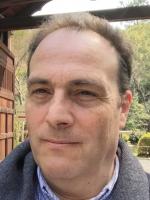
Career
- 2018-date: Royal Society E.P. Abraham Professor, DAMPT, Cambridge
- 2011-date: Herchel Smith Chair in Physics, Cavendish Laboratory,
- Cambridge
- 2002-2010: Personal Chair in the Theory of Condensed Matter, Cavendish Laboratory,
- Cambridge
- 2000-2002: University Readership in the Theory of Condensed Matter, Cavendish Laboratory, Cambridge
- 1995-1999: Lecturer, Cavendish Laboratory, Cambridge
- 1995-date: Fellow, St John’s College, Cambridge
- 1994-1995: Royal Society Research Fellow and Lecturer, Imperial College, London
- 1990-1991: Junior Research Fellow, Gonville and Caius College, Cambridge
Research
Ben is a member the Department of Applied Mathematics and Theoretical Physics and the Cavendish Laboratory, Department of Physics. He also holds affiliated positions in the Wellcome Trust/CRUK Gurdon Institute and the Wellcome Trust/MRC Stem Cell Institute. His research interests have spanned a wide range of topics within the area of theoretical quantum condensed matter physics. However, his current interests are focussed on the application of modelling approaches to study the dynamics of biological systems, from subcellular processes, to cell fate decision-making and morphogenic processes. His research is supported by grants from EPSRC, the Wellcome Trust, CRUK and the Royal Society.
Selected Publications
- S. Rulands, et al., Universality of clone dynamics during tissue development, Nature Physics 14, 469-474 (2018)
- E. Hannezo, et al., A unifying theory of branching morphogenesis, Cell 171, 242-255 (2017)
- X. Lan, et al., Cell fate mapping of human glioblastoma reveals an invariant stem cell hierarchy pre- and post-treatment, Nature 549, 227-232 (2017)
- A. Sanchez-Danes, et al., Defining the clonal dynamics leading to tumor initiation, Nature 536, 298-303 (2016)
- B. D. Simons and H. Clevers, Strategies of stem cell self-renewal in adult tissues, Cell 145, 851-862 (2011)
- C. Lopez-Garcia, et al., Intestinal stem cell replacement follows a pattern of neutral drift, Science 330, 822-825 (2010)
Publications
A computational pipeline for spatial mechano-transcriptomics
– Nat Methods
(2025)
22,
1
(doi: 10.1038/s41592-025-02618-1)
Corrections in single cell migration path in vivo are controlled by pulses in polar Rac1 activation
(2025)
(doi: 10.1101/2025.02.24.639819)
Spatio-temporal switches in progenitor cell fate govern upper hair follicle growth and maintenance
– Journal of Investigative Dermatology
(2025)
S0022-202X(25)00287-8
(doi: 10.1016/j.jid.2025.01.034)
Sustained NF-κB activation allows mutant alveolar stem cells to co-opt a regeneration program for tumor initiation
– Cell stem cell
(2025)
32,
375
(doi: 10.1016/j.stem.2025.01.011)
OLIG2 mediates a rare targetable stem cell fate transition in sonic hedgehog medulloblastoma.
– Nat Commun
(2025)
16,
1092
(doi: 10.1038/s41467-024-54858-y)
Coupling of cell proliferation to the segmentation clock ensures robust somite scaling
(2025)
(doi: 10.1101/2025.01.10.632257)
Gliomagenesis mimics an injury response orchestrated by neural crest-like cells.
– Nature
(2025)
638,
499
(doi: 10.1038/s41586-024-08356-2)
Self-organization of spermatogenic wave coordinates sustained sperm production in the mouse testis
(2024)
(doi: 10.1101/2024.11.03.621757)
Spatial Transcriptomics Reveals the Temporal Architecture of the Seminiferous Epithelial Cycle and Precise Sertoli-Germ Synchronization
– bioRxiv
(2024)
5,
2024.10.28.620681
(doi: 10.1101/2024.10.28.620681)
Mechanisms That Clear Mutations Drive Field Cancerization in Mammary Tissue
– Nature
(2024)
633,
198
(doi: 10.1038/s41586-024-07882-3)
- 1 of 30
